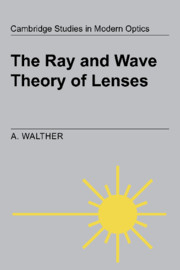Book contents
- Frontmatter
- Contents
- Preface
- Part one Preview
- Part two Geometrical optics
- Part three Paraxial optics
- 9 The small angle approximation
- 10 Paraxial calculations
- 11 Stops and pupils
- 12 Chromatic aberrations
- Part four Waves in homogeneous media
- Part five Wave propagation through lenses
- Part six Aberrations
- Part seven Applications
- Appendix 1 Fourier transforms
- Appendix 2 Third order calculations
- Appendix 3 Ray tracing
- Appendix 4 Eikonals and the propagation kernels
- Appendix 5 Paraxial eikonals
- Appendix 6 Hints and problem solutions
- Bibliography
- Index
10 - Paraxial calculations
Published online by Cambridge University Press: 22 September 2009
- Frontmatter
- Contents
- Preface
- Part one Preview
- Part two Geometrical optics
- Part three Paraxial optics
- 9 The small angle approximation
- 10 Paraxial calculations
- 11 Stops and pupils
- 12 Chromatic aberrations
- Part four Waves in homogeneous media
- Part five Wave propagation through lenses
- Part six Aberrations
- Part seven Applications
- Appendix 1 Fourier transforms
- Appendix 2 Third order calculations
- Appendix 3 Ray tracing
- Appendix 4 Eikonals and the propagation kernels
- Appendix 5 Paraxial eikonals
- Appendix 6 Hints and problem solutions
- Bibliography
- Index
Summary
Introduction
In this chapter we show how to calculate the paraxial properties of a lens when its construction parameters are specified. Rather than using the eikonal techniques of the previous chapter, we base this work on Snell's law and simple geometry. The results will be quite similar to what we found before; in particular we will rederive the linear equations connecting the ray parameters in the object and image space.
Why then did we bother with the heavy machinery of the previous chapters at all? There are two important reasons. First, in the current chapter we assume right from the start that all angles with the axis are small. Extending this work to larger angles leads to a thicket of thorny mathematics that firmly refuses to provide any general insights. Secondly, the eikonal functions introduced in the previous chapters play, as we shall see later, an indispensable role in the diffraction theory of image formation, where they appear again and again as phase functions in wave propagation integrals. Snell's law is not a suitable tool to clarify the relations between geometrical optics and the wave theory.
Notation and sign rules
An unambiguous notation is needed to keep track of the many parameters involved. The rules we shall use in this book are listed below.
(i) In the object space the light travels from left to right.
(ii) A lower case r denotes the radius of curvature of a lens surface. Its reciprocal 1/r is the curvature R.
Information
- Type
- Chapter
- Information
- The Ray and Wave Theory of Lenses , pp. 87 - 104Publisher: Cambridge University PressPrint publication year: 1995
